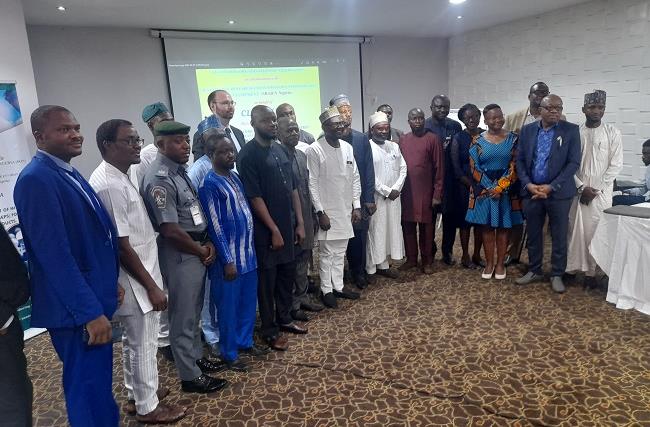Against the backdrop of the Minamata Convention on Mercury, Nigeria has taken first steps to move away from toxic, mercury-laden lighting to one that is non-toxic and energy efficient.

At the Inception Workshop on The Minimum Energy Performance (MEPS) and Labelling for Lighting in Nigeria, stakeholders gathered in Lagos on Tuesday, February 7, 2023, to deliberate on ways to replace the mercury added Compact and Linear Fluorescents Lamps (CFLs &LFLs) with Light-Emitting Diode (LED) Lightbulbs that do not pose a risk to health.
The initiative is being promoted by the Standards Organisation of Nigeria (SON) in collaboration with the Sustainable Research and Action for Environmental Development (SRADev Nigeria) on behalf of CLASP, USA.
Launched in 2013, the Minamata Convention on Mercury is an international treaty designed to protect human health and the environment from anthropogenic emissions and releases of mercury and mercury compounds. Nigeria ratified the Minamata Convention in 2018.
However, Minamata includes exemptions for mercury-based fluorescent lighting products.
But, according to Dr Leslie Adogame, Executive Director of SRADev, the rapid development and increasing accessibility and affordability of mercury-free LED lighting makes the exemption unnecessary.
“Eliminating exemptions for fluorescent lighting products at the next Conference of Parties (COP5) in 2023 would lead to a global phase-out by 2025 and accelerate a transition to LED lighting,” he said, adding that this is being pushed by the Clean Lighting Coalition Campaign, a coalition of governments that agree to eliminate the exemption for mercury-based lighting under the Minamata Convention.
Adogame added that a successful consensus to phase-out fluorescent lighting at the COP will accelerate this transition to clean, LED lighting and:
- Cut global electricity use by 3%,
- Eliminate 232 tonnes of mercury pollution from the environment, both from the bulbs themselves and from avoided burning of coal in power plants, and
- Avoid 3.5 gigatonnes of CO2 emissions cumulatively between 2025-2050, equivalent to getting all passenger cars (globally) off the road for a whole year.
Described as the most efficient light source on the market as they offer people, business and governments long- term cost-savings, LED retrofit bulbs are said to be easily available in lighting markets around the world, providing users with an improved lighting experience.
Adogame said: “African countries are all importers of fluorescent lighting; therefore, a phase-out of fluorescent lighting will have no negative socio-economic impacts on the local economies.
“Luckily, Africa is moving strongly in the direction of LED lighting technology, and phasing out fluorescent lamps will help eliminate mercury and save energy cost-effectively.
“Significant production already taking place in Africa, and many other businesses establishing and expanding themselves in linear and general service lamps as well as light fittings and luminaires.”
In a presentation titled “MEPS and Labeling for Lighting Products in Nigeria”, Colin Taylor, Senior Manager, Climate, CLASP, spoke on the potential benefits of Lighting MEPS for Nigeria, saying that this entails energy savings and fluorescent phase-out in 2025 (2025-50), financial savings of up to $2.47 billion, compact fluorescent lamp sales avoided and CFL phase-out in 2024 (cumulative, 2024-2050), linear fluorescent lamp sales avoided, LFL phase-out in 2025 (cumulative, 2025-2050), and 300 kilograms of Mercury in fluorescent lamps avoided (CFL and LFL phased out, cumulative 2024-2050).
He added that, on April 30, 2021, the African region (36 countries, now 38) submitted an Amendment on Lighting, with the intention to amend the fluorescent lamp exemptions to phase-out: Integrally ballasted CFLs by the end of 2024, Linear fluorescent lamps by the end of 2025, and CCFL and EEFL by the end of 2024.
“From March 21 to 25, 2022, Parties met in Bali, Indonesia at COP4 to discuss this and other proposed Amendments to the Convention,” he said, describing the project as an opportunity to accelerate phase-out of mercury lighting, as well as achieving public health, environmental and economic benefits for Nigeria.
Speaking on “Justification for MEPS Adoption, Technical Implementation Roadmap“, Owoeye Olakunle, a consultant on MEPS, said that MEPS on lighting can save up to 1,032MW of power demand, and that it is equivalent to avoided power plant that could cost $1.6 billion.
He added that there will be energy cost savings of more than 1000% over incandescent bulb and over 190% savings over CFL, and that energy saved is CO2 emission saved.
“It aligns with Nigeria Energy Transition Plan – 2060 carbon neutral goal, aligns with Climate Change Law, and aligns with the Nigeria Energy Plan,” added Olakunle.
